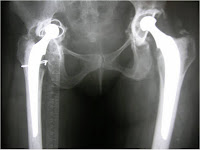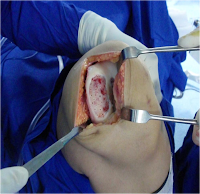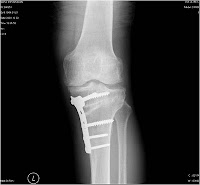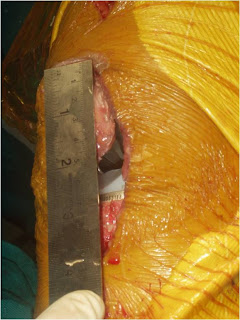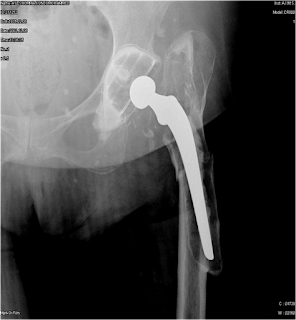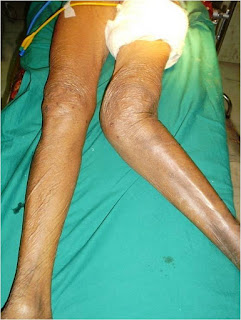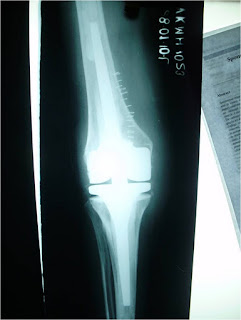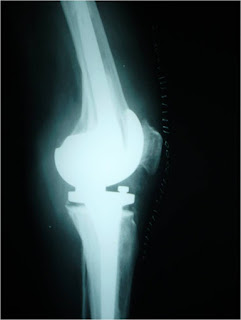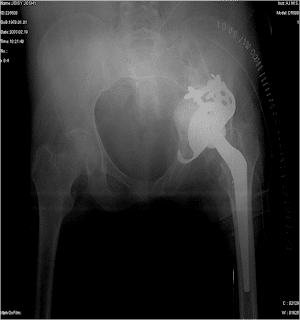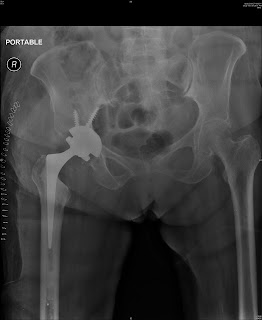A collection of complex joint preservation and replacement case studies and random thoughts of a orthopedic surgeon essentially aimed at knowledge dissemination.
Sunday 20 November 2011
Saturday 19 November 2011
Knee pain
Sports were designed to improve fitness of ordinary mortals. In our quest for higher level of fitness we sometimes damage joints beyond repair. Some amount of cyclical loading is good for cartilage (the softer shock absorbing ends of bones) nutrition. A Swedish prospective study comparing degenerative wear with exercise compared daily exercise, with thrice daily exercise and no exercise and concluded that thrice daily exercise probably had the least wear.
Once a mechanical change to the alignment or stability of knee occurs, it becomes the beginning of the end of knee. Ligament injuries which contribute to stability are akin to suspension and wheel alignment of our cars. Your continuous driving without correction wears out the tyres similar to the softer cartilage of the knee.
Pain is a protective phenomenon evolved to prevent further damage to oneself and administering of pain killers alone without investigation and treatment of the cause could further deteriorate the joint.. As far diagnosis of cartilage injuries, MRI scans upto 3 Tesla magnets with de-gemmeric software to look at cartilage has improved the diagnosis of cartilage injuries. These days easy reproducible minimal access surgery is available world wide to correct alignment, ligament reconstruction and resurfacing of cartilage injuries using osteoarticular grafts, bioscapholds and matrix assisted autologous implantation.
The use or abuse of exercise is ever increasing in our quest for healthier hearts. Over doing the same has exacerbated the possible incidence of osteoarthritis in knees. Weight reduction is the first simple step to reduce the wear across the cartilage. Six times one’s the body weight goes through our knees while walking. It is akin to driving a truck with cycle tyres. The smaller bony part of the knee has to take the excessive load which is already getting stiffer due to chemical changes and decrease water content with aging. Stronger and fitter muscles do take part of the load.
The role of neutrocaeuticals for arthritis has been controversial. Glucosamine and chondroitin sulphate are normal constituents of articular cartilage, but only 8% gets absorbed and how much reaches the knee is unclear. There are no studies to prove that the cartilage becomes normal with ingestion of neutricaeuticals. It at best could reduce the rate of degradation and might have analgesic effects. There use has been widespread so as to avoid the deleterious side effects of long term use of analgesics which are proven to cause Gastrointestinal and renal problems.
Viscosupplementation have been used to delay the inevitable and recently been talked about as a disease modifying intervention. This is yet to be proved and at best would be a stop gap arrangement till the inevitable knee replacement occurs.
Knee replacement has been shows to be in medium to long term, the best option once end stage arthritis occurs. Newer designs, materials like oxinium and crosslinking of polyethylene have proven to reduce the wear rates and improve the longevity of the implant. The complications of Pulmonary embolism, infection has been decreased with better drugs and early mobilization. As younger arthritic patients are demanding better function newer partial knees are being tested.
Reducing blood loss during joint replacement
Methods to avoid transfusion, more so in bilateral TKR are possibly being achieved by using transxemic acid ,Thrombin, aquamantis and other methods. Our preliminary trial shows a trend towards minimising blood loss in Rheumatoids and bilateral tkrs using FLOSEAL.
Does size matter
The size of the incision or the implant does nothing to the longeivity or function of the implants. It is the technique, quality of bearing, fixation and alignment which is paramount. The approach whether anterior or posterior if done well does not matter. Why are we stuck on the size? yes, it could be a marketing tool. These fads fade away and what matters most is the function and longievity. Smaller Proximal loading stems might have a role in preserving proximal bone. Till date No hip other than resurfacing maitain bone in gruen zone 1 and 6. With the metal on metal controversies surface replacement is used in select cases only.
Wounds heal side to side and possibly better rehab and multimodal analgesis will help to get the patient up quickly.
Thursday 17 November 2011
migrating stem
protrusio acetabuli in RA
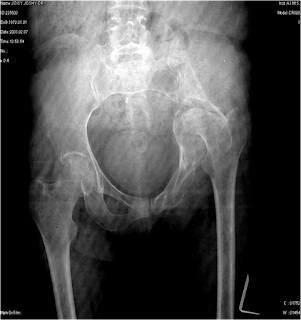
This is 36 year old Doctor with RA on long term steroids. Presented with pain in hip as well as knee.
Why do we wait to complicate reconstruction?
Problems
1. Severe Osteoporosis
2.Huge cavitatory acetabulum with deficient medial and anterior wall
Young patient
Any comments on Options for acetabular reconstruction.
We used a Cone prosthesis and a wagner uncemented cage with ceramic on poly bearing.A peripheral fitting cup was an option but due to the osteopenia, we opted for a cage which came in 2 sizes. I understand Zimmer has withdrawn both these products from Sulzer.
Dislocation in in bipolar of 3 weeks duration

76 year old female presented with dislocated bipolar of 3 weeks duration. she is asa gr 3, memory loss and is a household ambulator. The dislocation occured while sitting on the toilet
The lesser trochanter appears more prominent
Possible causes in general for dislocation
Inadequate Offset
abnormal version and impingement
Options
1. Closed reduction and abductor bracing
2.if found unstable at closed reduction the options
Subscribe to:
Posts (Atom)
